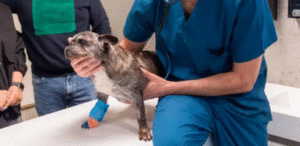Hip dysplasia is a common orthopedic condition in dogs, particularly in larger breeds. This malformation of the hip joint can lead to pain, decreased mobility, and a reduced quality of life. In Portland, Oregon, pet owners have access to innovative treatments like red light therapy to help manage this condition. For more information about red light therapy for dogs with hip dysplasia, click here.
 Red light therapy is an effective treatment for dogs with hip dysplasia, offering pain relief and improved mobility. By using specific wavelengths of light, this non-invasive therapy helps reduce inflammation and promotes the healing of damaged tissues. For pet owners in Portland, OR, several veterinary clinics provide this innovative treatment, ensuring pets can live more comfortably without relying solely on medication or surgery.
Red light therapy is an effective treatment for dogs with hip dysplasia, offering pain relief and improved mobility. By using specific wavelengths of light, this non-invasive therapy helps reduce inflammation and promotes the healing of damaged tissues. For pet owners in Portland, OR, several veterinary clinics provide this innovative treatment, ensuring pets can live more comfortably without relying solely on medication or surgery.
Additionally, at-home red light therapy devices allow for continued care. Always consult with a veterinarian before starting treatment to significantly ensure the safety and effectiveness of the therapy for your dog’s specific needs. Red light therapy enhances the quality of life for dogs with hip dysplasia.
Understanding Hip Dysplasia in Dogs
Hip dysplasia significantly occurs when the ball and socket joint of the hip don’t develop properly, significantly leading to joint instability and wear over time. It can result in arthritis, pain, and difficulty moving. Common symptoms include limping, stiffness, and reluctance to jump or climb stairs. While surgery is an option, many owners seek noninvasive treatments to alleviate symptoms and improve their dog’s comfort.
What Is Red Light Therapy?
Red light therapy, also popularly known as low-level laser therapy (LLLT), significantly uses specific wavelengths of light to penetrate tissues and stimulate cellular processes. This noninvasive treatment promotes healing, reduces inflammation, and alleviates pain. For dogs with hip dysplasia, red light therapy can be a highly effective adjunct to traditional treatments.
How Red Light Therapy Helps Dogs with Hip Dysplasia
Pain Reduction
Red light therapy can decrease pain by increasing the overall production of endorphins and reducing inflammation in the affected area. It leads to improved comfort and mobility for dogs suffering from hip dysplasia.
Improved Joint Mobility
By stimulating blood flow and effectively promoting tissue repair, red light therapy can enhance joint function. It is particularly beneficial for dogs with arthritis secondary to hip dysplasia, as it helps maintain or improve their range of motion.
Accelerated Healing
For dogs recovering from surgery or injury related to hip dysplasia, red light therapy can expedite the healing process. It encourages tissue regeneration and reduces recovery time, allowing dogs to return to their normal activities more quickly.
Availability of Red Light Therapy in Portland, OR
Portland offers several veterinary clinics that provide red light therapy for dogs with hip dysplasia:
- Irvington Veterinary Clinic: Offers noninvasive laser therapy to speed up healing and relieve pain, which is suitable for conditions like hip dysplasia.
- Portland Veterinary Wellness Center: Utilises the Companion Therapy Laser to treat chronic pain and arthritis, including hip dysplasia, without the side effects of pharmaceuticals.
- Northwest Neighborhood Veterinary Hospital: Provides laser therapy to treat arthritis and hip dysplasia, aiming to improve mobility and reduce pain.
At-Home Red Light Therapy Devices
Some pet owners opt for at-home red light therapy devices for ongoing management. These handheld units are designed for safe use on dogs and can be effective in reducing pain and inflammation associated with hip dysplasia. It’s essential to follow the manufacturer’s guidelines and consult with a veterinarian before starting at-home therapy.
Safety and Considerations
Red light therapy is significantly considered safe for dogs. However, it’s essential to use devices specifically designed for veterinary use and to follow recommended treatment protocols. Consulting with a veterinarian before beginning therapy ensures that it’s appropriate for your dog’s specific condition and needs.
Conclusion:
Red light therapy offers a promising, noninvasive option for managing hip dysplasia in dogs. In Portland, pet owners have access to veterinary clinics that provide this treatment and resources for at-home therapy. By incorporating red light therapy into a comprehensive treatment plan, dogs with hip dysplasia can experience reduced pain, improved mobility, and a much better quality of life.